 |
| looking west and a little north in southern Boulder, Colorado |
September is near the end of the growing season in Boulder. Frosts and snowstorms are uncommon but not unknown. Most likely, though, it will be nice through November, so the plants can open a few more flowers and produce additional seeds.
I walked a short distance from the Marshall Mesa Trailhead. This area burned in the Marshall Fire of December 30, 2021 and I looked for the effects.
 |
| White asters (Symphyotrichum) and yellow broom snakeweed (Gutierrezia) |
The plants were heavy with developing seeds. It looks dry and dusty since the soil is reddish and leaves are yellowing in preparation for winter, but close-up, the plants had a few flowers still open and most had lots of developing seeds.
In fact, to anthropomorphize, these plants look smug. They are loaded with seeds, the sign of a good year. Not often do they grow so many shoots or produce so many seeds.
Comments and corrections welcome.
 |
| Goldenrod, probably baby goldenrod, Solidago nana |
 |
| snow-on-the-mountain, Euphorbia marginata |
In fact, to anthropomorphize, these plants look smug. They are loaded with seeds, the sign of a good year. Not often do they grow so many shoots or produce so many seeds.
This piece of the Boulder open space burned in December, 2021, in the Marshall Fire. The Marshall Fire destroyed 1,084 buildings in wide area stretching east of where I stood. The human-developed areas have barely begun to recover; rebuilding whole neighborhoods of houses will easily take five years.
In the grassland, however, it was difficult to see there had been a fire. That is partly because grasslands are mostly herbaceous plants, of which the majority regrow from underground each year. The fire burned up dead leaves and stalks, so of course you can't see them; they turned to smoke. Or ash, but that must have blown off or been incorporated in the soil this summer.
Rainfall so far in 2022 has been just over the average. (This is the 51st wettest of 128 years observed, whole-year average rainfall is 21.23". It is dry at the base of the Rocky Mountains). But it is a better-than-average flowering year. Probably some of this is a response to the fire. Fire leaves ash, containing nutrients, on the soil. It clears off the dead leaves of previous years. In a climate where rain storms tend to bring a quarter inch (0.25") of rain, sprinkling that on a gravelly soil will let more of it into the ground where roots can find it, rather than hang up in old leaves to evaporate away.
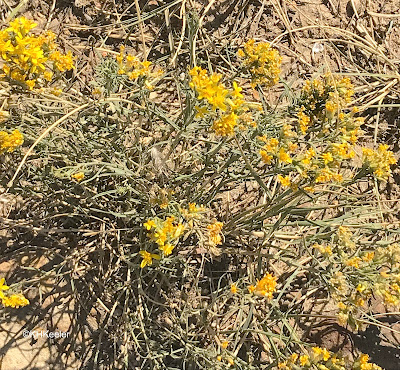 |
| broom snakeweed, Gutierrezia sarothrae |
 |
| goldenrod, Solidago, probably baby goldenrod, S. nana |
The shrubs do show there was a fire:
This is three-leaf sumac, Rhus trilobata, resprouting below the stems and branches the fire killed.
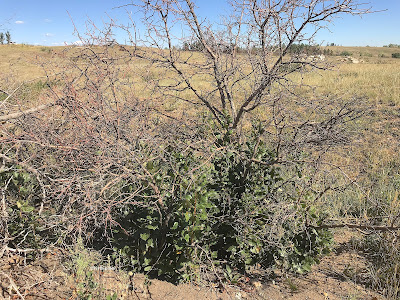 |
| Green leaves and new stems of three-leaf sumac came up from the roots this spring, after the fire killed the aboveground plant |
Small soap weed (Yucca glauca) also came back up from the roots, last year's leaves were killed by the fire:
 |
| small soapweed, Yucca glauca |
There may be other effects that promote plant growth and flowering after a fire. The reddish grass growing between the rocks is big bluestem, Andropogon gerardii. Big bluestem is one of the most famous plants for being stimulated by fire. The plants grow taller and flower more the growing season after a fire. A major reason for that is that bare soil warms in the spring sunshine as much as two weeks sooner than soil shaded by dead leaves. Big bluestem takes advantage of those extra weeks of warmth to grow more, so it has more resources to put into flowers, and flowers much more after a fire. Big bluestem is not particularly common in Boulder's open space; Boulder is the western end of its range (which goes east to the the Atlantic Ocean). Most years these plants are invisible, just a few 3-4" leaves poking up between the rocks. This year they are taller with many flower stalks.
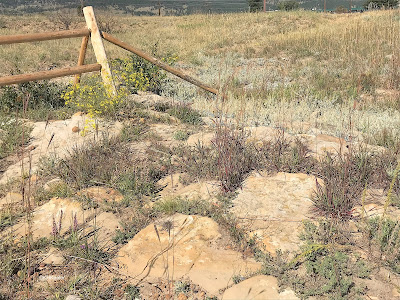 |
| big bluestem, Andropogon gerardii is the reddish grass sending up two and three-foot flower stalks |
Other plants looked well too:
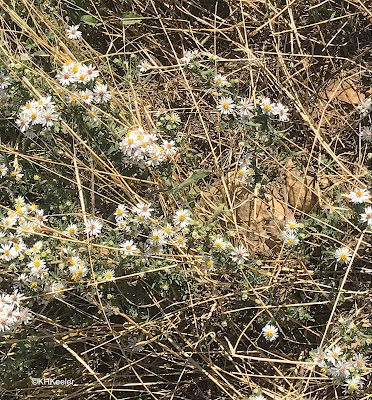 |
| aster, Symphyotrichum (either S. ericoides or S. falcatum, both are white and common) |
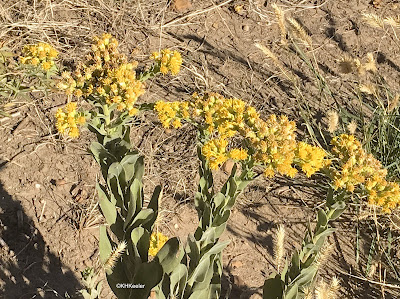 |
| stiff goldenrod, Solidago rigida |
Fire regularly swept the natural communities of most of North America; plants that couldn't resprout went extinct from those ecosystems. Fire frequency in the Ponderosa pine forests of the Rocky Mountains was historically about every 230 years, while fire frequency in the moist eastern prairies of Iowa was every 1-5 five years. The dry western steppes at the base of the Rockies burned infrequently, estimated as every 5-10 years, because the plants, as you see in my photos, are separated by rocks and bare ground, so fires don't carry particularly well. But even a dry grassland will build up enough plant litter to carry a fire after a while, so here as elsewhere, the plants are adapted to resprout and some, like big bluestem, benefit from the post-fire conditions.
The contrast with the destruction of human structures is striking. The plant tops burn off and then grow back. Grassland animals move out of the way of fires, then return to eat the new green shoots the plants send up. I don't suppose humans would be willing to live so that, if a fire threatened, they could duck underground or move their possessions out of the way. But we aren't going to end fires. The conditions--dry plants and sparks--won't go away. I walk the grassland, admiring its recovery, and wonder how we can learn from nature.
References
Higuera, P., B. Shuman and K. Wolf. 2021. Rocky Mountain forests burning more now than any time in the last 2,000 years. The Conversation. link (accessed 9/25/22).
National Park Service. Wildland fire in tallgrass prairie: Midwestern United States. link (accessed 9/25/22).
North American Shortgrass Prairies. WRANGLE (World Rangeland Learning Experience) link (accessed 9/25/22).
My career was as a grassland ecologist. I came to Colorado originally to compare big bluestem in the grasslands at the base of the Rockies to grasslands in eastern Nebraska and Kansas.
Kathy Keeler, A Wandering Botanist
More at awanderingbotanist.com
Join me on Facebook: https://www.facebook.com/AWanderingBotanist
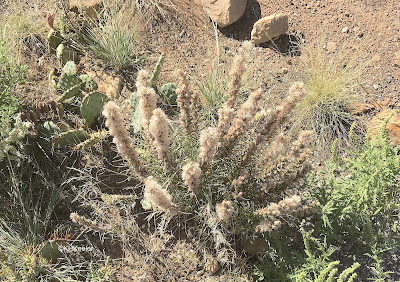
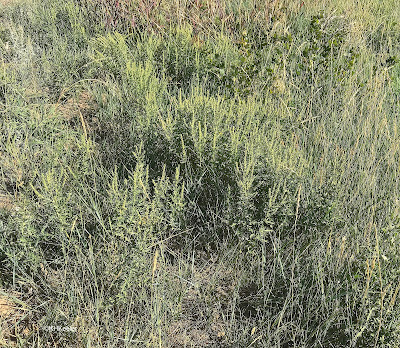
A wee copy edit: for the asters, did you mean Symphyotrichum?
ReplyDeleteYes, I check and check and misspellings still get through. I changed it. Thank you.
Delete